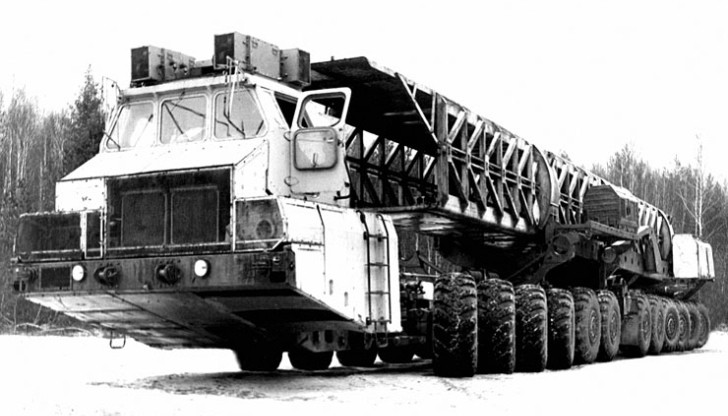The Russians are known for making things on a gigantic scale. Call it megalomania, but the ex Soviets left behind some marvelous extinct creations for us to wonder at, just like dinosaurs. They made the largest helicopters, the largest jet planes and today we also learned about the largest truck.
It's called the MAZ-7907 and it was developed in the 1980s by the Minsk Automotive Plant known as MZKT. It was designed to do one thing: carry the new RT-23 nuclear missile. The intercontinental ballistic missile could carry up to ten individual warheads and travel up to 10,000 kilometers, essentially, the distance between Moscow and Los Angeles.
But there was a problem: the RT-23 weighed over 100 tons, a logistical nightmare. It was originally designed to be transported and launched from a train, but a truck was also commissioned to carry it in 1983.
By 1985, the first two MAZ-7907 had been built. The giants had a total length of 28.1 meters, measured 4.1 meters from side to side and the cabin was 4.45 meters tall. Up to 150 tons could be placed on top of these goliaths, which had a long suspension travel to cope with the rough roads.
Two gas turbine engines, like the ones used in aviation, were installed. But the 1250 horsepower they generated was used to create electricity, not power the truck directly. This in turn fed 24 individual electric motors, one for each wheel.
To ensure tight turns were possible, the MAZ-7907 had 8 movable axles. Just like on a forklift, the wheels could turn in synchronously (a crabbing motion) or asynchronously (the first four axes in one direction, and the last four the opposite).
According to Mail.ru, this amazing and reclusive vehicle was used in 1996 to carry an 88-ton ship from the Berezina river to lake Narach (in Belarus). It performed its task well and reached a cruising speed of 20 km/h on some portions of the 250-kilometer trip, but broke down afterwards and had to be towed.
But there was a problem: the RT-23 weighed over 100 tons, a logistical nightmare. It was originally designed to be transported and launched from a train, but a truck was also commissioned to carry it in 1983.
By 1985, the first two MAZ-7907 had been built. The giants had a total length of 28.1 meters, measured 4.1 meters from side to side and the cabin was 4.45 meters tall. Up to 150 tons could be placed on top of these goliaths, which had a long suspension travel to cope with the rough roads.
Two gas turbine engines, like the ones used in aviation, were installed. But the 1250 horsepower they generated was used to create electricity, not power the truck directly. This in turn fed 24 individual electric motors, one for each wheel.
To ensure tight turns were possible, the MAZ-7907 had 8 movable axles. Just like on a forklift, the wheels could turn in synchronously (a crabbing motion) or asynchronously (the first four axes in one direction, and the last four the opposite).
According to Mail.ru, this amazing and reclusive vehicle was used in 1996 to carry an 88-ton ship from the Berezina river to lake Narach (in Belarus). It performed its task well and reached a cruising speed of 20 km/h on some portions of the 250-kilometer trip, but broke down afterwards and had to be towed.








